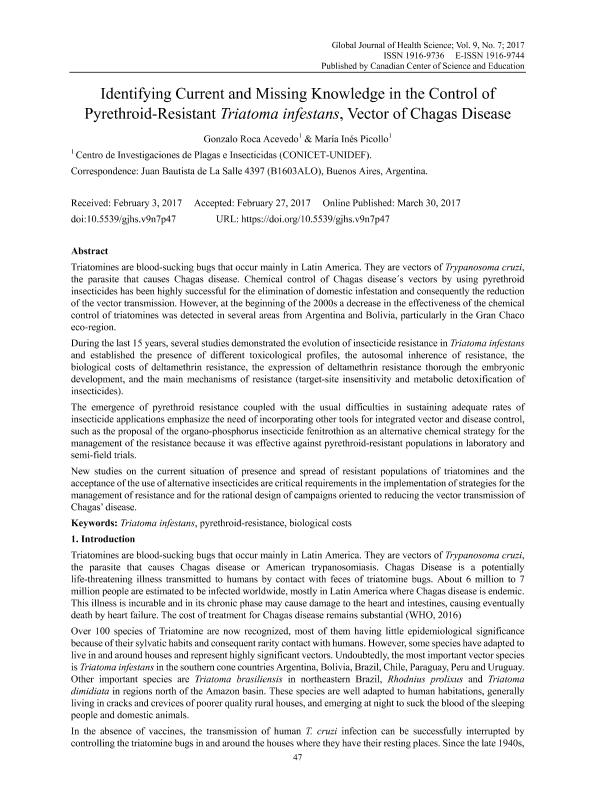Mostrar el registro sencillo del ítem
dc.contributor.author
Roca Acevedo, Gonzalo

dc.contributor.author
Picollo, Maria Ines

dc.date.available
2018-05-04T19:34:03Z
dc.date.issued
2017-03
dc.identifier.citation
Roca Acevedo, Gonzalo; Picollo, Maria Ines; Identifying Current and Missing Knowledge in the Control of Pyrethroid-Resistant Triatoma Infestans, Vector of Chagas Disease; Canadian Center of Science and Education; Global Journal of Health Science; 9; 3-2017
dc.identifier.issn
1916-9744
dc.identifier.uri
http://hdl.handle.net/11336/44214
dc.description.abstract
Triatomines are blood-sucking bugs that occur mainly in Latin America. They are vectors of Trypanosoma cruzi, the parasite that causes Chagas disease. Chemical control of Chagas disease´s vectors by using pyrethroid insecticides has been highly successful for the elimination of domestic infestation and consequently the reduction of the vector transmission. However, at the beginning of the 2000s a decrease in the effectiveness of the chemical control of triatomines was detected in several areas from Argentina and Bolivia, particularly in the Gran Chaco eco-region. During the last 15 years, several studies demonstrated the evolution of insecticide resistance in Triatoma infestans and established the presence of different toxicological profiles, the autosomal inherence of resistance, the biological costs of deltamethrin resistance, the expression of deltamethrin resistance thorough the embryonic development, and the main mechanisms of resistance (target-site insensitivity and metabolic detoxification of insecticides). The emergence of pyrethroid resistance coupled with the usual difficulties in sustaining adequate rates of insecticide applications emphasize the need of incorporating other tools for integrated vector and disease control, such as the proposal of the organo-phosphorus insecticide fenitrothion as an alternative chemical strategy for the management of the resistance because it was effective against pyrethroid-resistant populations in laboratory and semi-field trials. New studies on the current situation of presence and spread of resistant populations of triatomines and the acceptance of the use of alternative insecticides are critical requirements in the implementation of strategies for the management of resistance and for the rational design of campaigns oriented to reducing the vector transmission of Chagas’ disease.
dc.format
application/pdf
dc.language.iso
eng
dc.publisher
Canadian Center of Science and Education
dc.rights
info:eu-repo/semantics/openAccess
dc.rights.uri
https://creativecommons.org/licenses/by-nc-sa/2.5/ar/
dc.subject
Triatomines
dc.subject
Pyrethroid-Resistance
dc.subject
Missing Knowledge
dc.subject.classification
Otras Ciencias Biológicas

dc.subject.classification
Ciencias Biológicas

dc.subject.classification
CIENCIAS NATURALES Y EXACTAS

dc.title
Identifying Current and Missing Knowledge in the Control of Pyrethroid-Resistant Triatoma Infestans, Vector of Chagas Disease
dc.type
info:eu-repo/semantics/article
dc.type
info:ar-repo/semantics/artículo
dc.type
info:eu-repo/semantics/publishedVersion
dc.date.updated
2018-05-04T14:55:58Z
dc.journal.volume
9
dc.journal.pais
Canadá

dc.description.fil
Fil: Roca Acevedo, Gonzalo. Consejo Nacional de Investigaciones Científicas y Técnicas. Unidad de Investigación y Desarrollo Estratégico para la Defensa. Ministerio de Defensa. Unidad de Investigación y Desarrollo Estratégico para la Defensa; Argentina
dc.description.fil
Fil: Picollo, Maria Ines. Consejo Nacional de Investigaciones Científicas y Técnicas. Unidad de Investigación y Desarrollo Estratégico para la Defensa. Ministerio de Defensa. Unidad de Investigación y Desarrollo Estratégico para la Defensa; Argentina
dc.journal.title
Global Journal of Health Science
dc.relation.alternativeid
info:eu-repo/semantics/altIdentifier/doi/http://dx.doi.org/10.5539/gjhs.v9n7p47
dc.relation.alternativeid
info:eu-repo/semantics/altIdentifier/url/http://www.ccsenet.org/journal/index.php/gjhs/article/view/66161
Archivos asociados
